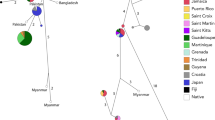Abstract
The Chequered Skipper butterfly (Carterocephalus palaemon) is extinct in England but extant in Scotland and Continental Europe. The possibility of re-introducing the species is under active consideration by conservation bodies, but ecological differences between Scottish and English populations raise the question of which populations should donate individuals, Continental European, or Scottish? We used mitochondrial DNA sequences (CO I, CO II and Cyt b) from potential donor populations to test the hypothesis that ecological differences could have arisen as a result of differing routes of post-glacial colonisation from separate refugia and subsequent isolation of UK populations. Shared haplotypes between populations in Belgium, Norway, Scotland and England provides no evidence to support the hypothesis that populations in Scotland result from an alternative post-glacial colonisation route. As the genetic evidence remains equivocal we suggest that choice of donor stock for a re-introduction to England should be made primarily on ecological grounds.
Similar content being viewed by others
References
Asher J., Warren M., Fox R., Harding P., Jeffcoate G. and Jeffcoate S. 2001. The Millenium Atlas of Butterflies in Britain and Ireland. Oxford University Press, Oxford.
Clary D.O. and Wolstenholme D.R. 1985. The mitochondrial DNA molecule of Drosophila yakuba: nucleotide sequence, gene organisation and genetic code. J. Mol. Evol. 22: 252-271.
Coope G.R. 1994. The response of insect faunas to glacialinterglacial climatic fluctuations. Philos. Trans. R. Soc. Lond. B 344: 19-26.
Crandall K.A., Bininda-Emonds O.R.P., Mace G.M. and Wayne R.K. 2000. Considering evolutionary processes in conservation biology. Trend. Ecol. Evol. 15: 290-295.
Dennis R.L.H. 1977. The British Butterflies. Their Origin and Establishment. E. W. Classey, Faringdon, Oxon.
Hewitt G.M. 1993. After the ice: Parallelus meets Erythropus in the Pyrenees. In: Harrison R.G. (ed.), Hybrid Zones and the Evolutionary Process, Oxford University Press, New York, pp. 140-164.
Higgins L.G. and Riley N.D. 1970. A Field Guide to the Butterflies of Britain and Europe. Collins, London.
Huntley B. and Birks H.J.B. 1983. An Atlas of Past and Present Pollen Maps for Europe. Cambridge University Press, Cambridge.
Joyce D.A., Pullin A.S. 2001. Phylogeography of the marsh fritillary Euphydryas aurinia (Lepidoptera: Nymphalidae) in the UK. Biol. J. Linn. Soc. 72: 129-141.
Moritz C., Heideman A., Geffen A. and McRae P.M. 1997. Genetic population structure of the Greater Bilby Macrotis lagotis, a marsupial in decline. Mol. Ecol. 6: 925-936.
Moritz C. 1994. Defining 'Evolutionary Significant Units' for conservation. Trend. Ecol. Evol. 9: 373-375.
Ravenscroft N.O.M. 1992. The ecology and conservation of the chequered skipper butterfly Carterocephalus palaemon (Pallas). PhD thesis, University of Aberdeen.
Ravenscroft N.O.M. 1994a. The ecology of the chequered skipper butterfly Carterocephalus palaemon (Pallas) in Scotland I. Microhabitat. J. Appl. Ecol. 31: 613-622.
Ravenscroft N.O.M. 1994b. The ecology of the chequered skipper butterfly Carterocephalus palaemon (Pallas) in Scotland II. Foodplant quality and population range. J. Appl. Ecol. 31: 623-630.
Santucci F., Emerson B.C. and Hewitt G.M. 1998. Mitochondrial DNA phylogeography of European hedgehogs. Mol. Ecol. 7: 1163-1172.
Simon C., Francesco F., Beckenbach A., Crespi B., Liu H. and Flook P. 1994. Evolution, weighting and phylogenetic utility of mitochondrial gene sequences and a compilation of conserved polymerase chain reaction primers. Ann. Entomol. Soc. Am. 87: 651-701.
Stewart J.R. and Lister A.M. 2001. Cryptic northern refugia and the origins of modern biota. Trend. Ecol. Evol. 16: 608-613.
Stockwell C.A., Mulvey M. and Jones A.G. 1998. Genetic evidence for two evolutionary significant units of White Sands pupfish. Anim. Conserv. 1: 213-225.
Taberlet P., Fumagalli L., Wust-saucy A. and Cossons J.F. 1998. Comparative phylogeography and postglacial colonisation routes in Europe. Mol. Ecol. 7: 453-464.
Tamura K. and Nei M. 1993. Estimation of the number of nucleotide substitutions in the control region of mitochondrial DNA in humans and chimpanzees. Mol. Biol. Evol. 11: 154-157.
Warren M.S. 1991. The Chequered Skipper Carterocephalus palaemon in Northern Europe: British Butterfly Conservation Society Occasional Paper no. 2. Colchester, Essex.
Young M.R. and Ravenscroft N.O.M. 1991. Conservation of the Chequered Skipper butterfly (Carterocephalus palaemon Pallas) in Scotland. Nature Conservancy Council Report, Peterborough.
Author information
Authors and Affiliations
Corresponding author
Rights and permissions
About this article
Cite this article
Joyce, D., Pullin, A. Using genetics to inform re-introduction strategies for the Chequered Skipper butterfly (Carterocephalus palaemon, Pallas) in England. Journal of Insect Conservation 8, 69–74 (2004). https://doi.org/10.1023/B:JICO.0000027510.59074.16
Issue Date:
DOI: https://doi.org/10.1023/B:JICO.0000027510.59074.16




